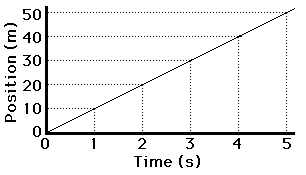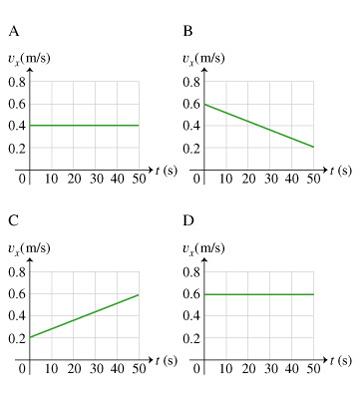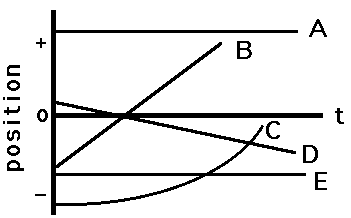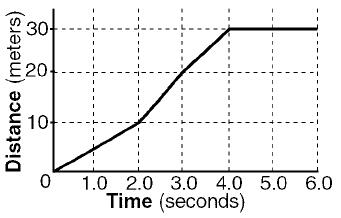The driver steps on the gas pedal and the car starts moving faster and faster. Just as speed is the rate of change of position, _________________ is the rate of change of velocity.
Acceleration.
When you think of acceleration, you probably think of something speeding up. However, an object that is _________________ ______________ is also accelerating.
Slowing Down,
OR
changing direction (or even going from a positive to negative velocity)
Just as the slope of a line on a distance-time graph is the object's speed, the slope of a line on a speed-time graph is the object's _____________________.
Acceleration.
Formula for Acceleration? Be EXACT! (If you answer this one incorrect you are deducted points!)
or just
A= (Vf-Vi)/t
What is the acceleration of the object in the first 5 seconds?
The slope of a position vs. time graph tells about speed or velocity. Since the slope for the first 5 seconds is CONSTANT, this means that the velocity is constant, which means the velocity doesn't change.
A velocity that doesn't change means there is ZERO acceleration. You can try this in the acceleration equation:
Pretend that Vi=Vf = 5 (constant velocity that doesn't change)
A=(Vf-Vi)/t = 0/t .... so no matter how long this happens for, the numerator is zero so A=0 too
 The object is doing this between point E and F
The object is doing this between point E and F
(your answer should include a number to say how much it is doing this)
Constant Negative Acceleration.
acceleration is the slope of a velocity vs. time graph (this is speed vs. time, which works the same)
between E & F, the slope = rise/run, or -20 m/s (rise) / 5 seconds (run), so the slope = accel = -4 m/s^2
Daily Double!
What is the difference between velocity and speed?
Velocity has magnitude and direction;
Speed has magnitude only.
Student groups are asked to measure the speed of a toy car as it moves across a track on the floor. What instruments will be needed to complete the lab activity?
A meter stick and a stopwatch/timer.
A student on a field trip in Coach Williamson's class jumps from an airplane for no apparent reason. After 4 seconds, the student has a velocity of 36 m/s. Which of the following is the acceleration of the student if he began with an initial velocity of 0 m/s?
9 m/s2
A motorcycle has a velocity of 6 m/s. When needing to pass another car on the road, the motorcycle acccelerates to 15 m/s. This process takes 3 seconds. What is the acceleration of the motorcycle?
3 m/s2
You're going skiing because skiing is awesome. You're standing at the top of the hill and take 3 seconds to get to your top speed, 15 m/s. Having enough fun, you cruise at 15 m/s for 20 seconds and then take 10 seconds to come to a stop.
This was your acceleration for the first 3 seconds of the trip
You got a ton of information on this question, but you only need to know about acceleration for the first 3 seconds. Sifting through the data, you see that you start at a standstill (Vi = 0), get to 15 m/s (Vf=15), and it takes 3 seconds for this to happen (t=3). Set up in the equation gives (15-0)/3 = 5 m/s^2
 What is the speed of the object at t=3 seconds, as represented by the graph?
What is the speed of the object at t=3 seconds, as represented by the graph?
10 m/s
slope of a displacement or position vs. time graph = velocity (or speed if we're ignoring signs)
If you go to Lagoon and get on a carousel, you'll end up going around and around with a constant rate of rotation.
Are you accelerating?
YES. Speed of rotation may be the same, but if you're going in a circle, you are constantly changing direction.
Remember, change in velocity gives you acceleration, and velocity is made up of speed IN A CERTAIN DIRECTION. If the direction changes, velocity has changed too, and you end up with an acceleration!

Which of these shows an object that accelerates at 0.008 m/s2?
A & D show no acceleration since the slope of each is 0. To find the acceleration of the other two, find the slope of each.
Slope = rise/run, so on graph C, the line starts on 0.2 and goes to 0.6 on the Y-axis. This gives a rise=0.4 m/s. The run on the X-axis is 50 sec, so rise/run = 0.4/50 = 0.008. Graph B has a similar slope but it is NEGATIVE (going downhill, or slowing down)

When does the object have the greatest acceleration?
ONLY C IS ACCELERATING. Since this is a position vs. time graph, slope = velocity. All lines that are straight mean the velocity is constant (which means zero acceleration).
Since the slope of C is changing, and since slope on this graph=velocity, you can say velocity changes. change in velocity =acceleration.
A plane is flying straight and level at 120 m/s. Then, to increase the "ooooh, ahhhh!" factor, it speeds up until it is going 200 m/s. If it takes 25 seconds to speed up, what is the plane's acceleration?
A = (Vf-Vi)/t, so
Vf = 200, Vi=120, t=25
so (200-120)/25 = 3.2 m/s^2
 These graph[s?] show an object that is moving at a constant velocity
These graph[s?] show an object that is moving at a constant velocity
A & D
these are each velocity vs. time graphs, this means that slope = acceleration. A & D have zero slope since they're horizontal lines, so this means they have zero acceleration. acceleration means how much velocity changes though, so if velocity doesn't change, it MUST be constant.
You could also just look at the Y-axis. Since these are V vs. T graphs, the Y-axis tells you how fast something is going. Just find the graphs where the line is the same across all measured time.
Let's accelerate a mini-fridge from 12 m/s to 500 m/s. To make it more interesting, we're accelerating it at a rate of 100 m/s2, or roughly 10 g's worth of acceleration. How long would it take for the minifridge to get to this new velocity?
Again, using A=(Vf-Vi)/t, but solving for t.
t=(Vf-Vi)/A
12m/s =Vi, 500m/s =Vf, then A=100m/s2 (you can tell from the units which is which. the 10 g's doesn't matter at all.
Plug & chug gives: t = (500-12)/100 = 4.88 sec
What does it mean when the number to your acceleration problem is negative?
it means that the object is slowing down.
What is the acceleration from 0 to 0.4 seconds?

ZERO!!! this is a position vs time graph, so slope = velocity. Since the slope during that time isn't changing, this means that velocity isn't changing, which means A=0
Name the three types of ways an object can "accelerate".
A. Speeding Up
B. Slowing Down
C. Changing Direction
A rocket speeds up at a rate of 0.022 km/s2. Its starting velocity is 8 km/s. If it accelerates for 75 seconds, what is it's new velocity?
Identifying variables first:
you can tell from the units of the first number that a=0.022. Vi=8 since we start at that velocity. t=75 seconds, and since everything has similar units there is nothing to convert.
Now just shove the numbers into
a= (Vf-Vi)/t, then solve for Vf.
Vf=a*t+Vi so Vf= 0.022*75+8 = 9.65 m/s
If you could travel in the speed of light (about 300,000,000 m/s) how many times could you travel around the Earth in 5 seconds?
The distance around the earth is about 40,000,000 m.
V=d/t
v=300,000,000
d=40,000,000
t=d/V = 0.13 SEC per trip around the earth., or
1/.13 = 7.5 TRIPS per sec. Then *5 to get number of trips per 5 sec = 37.5
 How far does the object go in 3 seconds?
How far does the object go in 3 seconds?
Lucky you, this is a distance vs. time graph, so the Y-axis tells you how far you went. at t=3 seconds, the Y-axis is at 20m, so
d=20m
What is the difference between velocity & acceleration?
Velocity is displacement divided by time, or more simply just how fast you're going in a certain direction.
Acceleration is how fast your velocity *changes*, or
a=(Vf-Vi)/t